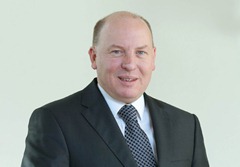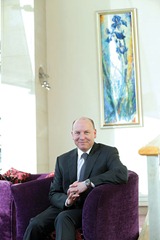EirGrid’s Fintan Slye: delivering our electric future
 Investing in the electricity grid is essentially for achieving Northern Ireland’s ambitious renewable energy targets. EirGrid Chief Executive Fintan Slye discusses the all-island system operator’s ambitions for the energy sector with Owen McQuade.
Investing in the electricity grid is essentially for achieving Northern Ireland’s ambitious renewable energy targets. EirGrid Chief Executive Fintan Slye discusses the all-island system operator’s ambitions for the energy sector with Owen McQuade.
The island of Ireland’s shift towards renewable electricity, North and South, can only be delivered through sustained investment into the transmission grid, according to EirGrid Chief Executive Fintan Slye. The Dublin man, appointed to the post in October, oversees the operation of the Single Electricity Market (SEM) as well as the electricity transmission grid in Ireland and Northern Ireland, a strategic part of the island’s infrastructure.
“In our position of running the electricity market and operating the transmission system,” Slye explains, “we essentially hold a central role in the electricity market across the island, interacting with all major players from generators and suppliers to large customers and the distribution system operators in NIE and ESB.”
EirGrid owns the System Operator Northern Ireland (SONI), which operates the province’s high voltage electricity grid. The balance of supply and demand is managed 24-7 from SONI’s headquarters at Castlereagh House, on the outskirts of Belfast. The Single Electricity Market Operator (SEMO) team is based in Belfast and Dublin.
Looking forward, Slye identifies four key challenges facing EirGrid as an organisation, the first being “continued and increased operational excellence” in service delivery as “having a secure, stable electricity system is critical for industry, for the economy and for society.”
Secondly, ensuring the delivery of the new transmission grid will also be an important priority. “The infrastructure across the island of Ireland needs to be significantly upgraded and delivering large-scale transmission infrastructure is never easy,” he remarks.
EirGrid has a greater role in infrastructure delivery in the Republic of Ireland where it takes projects through the planning system. NIE undertakes that process in Northern Ireland with the support of SONI.
In that context, the second North/South Interconnector (between County Tyrone and County Meath) is “absolutely critical” for Northern Ireland’s security of supply. The interconnector has been delayed, pending the outcome of public planning processes in Northern Ireland and the Republic of Ireland, but has been recognised by key political and industry stakeholders as a vital development for the economy and society as a whole.
When completed, it will ensure that the two jurisdictions are properly coupled within the Single Electricity Market with a common security of supply and unconstrained access in both Ireland and Northern Ireland to the cheapest generation on the island.
Slye elaborates: “If we look forward to 2016 and beyond, while there is a surplus of capacity across the entire island, capacity margins will potentially be tight in Northern Ireland. Without a second interconnector, Northern Ireland potentially has a security of supply issue and the market will not have access to the cheapest generation across the island.”
The third challenge is to facilitate regional integration with Ireland’s neighbours. With the EU target model due to be implemented by 2016, a major transformation is needed to ensure that the energy market here is developed to be compatible with the new European target market in electricity.
Several features of the current market have proven benefits for Ireland and Northern Ireland and need to be preserved. The pool system in the SEM is “very favourable” for small renewables as it pays suppliers for their output without requiring them to explicitly match that to demand. Both Northern Ireland and the Republic of Ireland also have higher ambitions for renewables than Great Britain. Northern Ireland and the Republic aim to generate 40 per cent of their electricity from renewables by 2020.
Britain’s electricity market is almost ten times larger than that of the SEM and is based on bilateral contracts between producers and suppliers. The UK Government, though, is considering a move towards capacity payments and increased transparency, key features of the SEM market used on this side of the Irish Sea.
Interconnection
The €600 million East-West Interconnector between County Dublin and North Wales represents EirGrid’s commitment to increasing the physical interconnection between Ireland and Great Britain. Construction on the 500MW link started in July 2010 and it was officially opened on 20 September. Testing is currently taking place and the interconnector will be in full commercial operation in the near future.
“Undoubtedly, further interconnection will be required between this island and Britain, and potentially even Europe,” he adds. EirGrid is now considering whether the next interconnector should again cross the Irish Sea or go south to France.
EirGrid’s fourth challenge is to drive innovation in smart grids and therefore capitalise on Ireland’s unique energy shift. “No-one in the world is operating a system with an instantaneous 50 per cent share of wind energy, except the island of Ireland,” Slye says. “No-one in the world is even dreaming of 75 per cent, which we need to do by 2020.”
He is confident that a 75 per cent renewables share in real time can be achieved but that will require new and innovative solutions for operating the power system. EirGrid is investing heavily in developing those technologies and deploying them across the grid (see box).
Delivering infrastructure is EirGrid’s key short-term priority while the medium term priority, in turn, will be delivering the EU model. Major decisions on the re-design of the market will be taken over the next 18 months. Maintaining the roll-out of the grid for renewables is the organisation’s main engineering challenge leading up to 2020.
 “We always have placed a high priority on the efficient operation of the system and as we continue to operate the system, the levels of complexity are increasing and will continue to increase. In the next 12-18 months, some of the large transmission infrastructure projects, North and South, will re-enter the planning process.”
“We always have placed a high priority on the efficient operation of the system and as we continue to operate the system, the levels of complexity are increasing and will continue to increase. In the next 12-18 months, some of the large transmission infrastructure projects, North and South, will re-enter the planning process.”
Two of the most significant projects will be GridWest, into Mayo, and GridLink, between Dublin and Cork. GridLink’s study area covered almost half of the Republic’s territory and after a preliminary 18-month study, EirGrid is now preparing to consult with communities along the route corridors in a much more focused way.
Delivering those four challenges depends on two key enabling factors: credibility and trust with stakeholders, and developing its people.
EirGrid’s stakeholders include local communities, along with regulators, governments and the industry. Trust from all of those groups is needed to gain social acceptance for the large-scale transmission grid that will be needed to accommodate renewables.
“To meet all of those challenges,” he adds, “we need to have the right people with the right capabilities and the right skills in place.”
Smart grid strategy
EirGrid’s smart grid strategy covers four strands.
The DS3 programme involves projects to transform how the power system is operated and includes reviews of system services and system protection. An industry advisory council is in place and meets quarterly.
A technology work stream is examining which new advanced technologies can be effectively deployed. This has already resulted in the deployment of high temperature, low sag conductors on transmission lines (substantially increasing the amount of transmitted power without changing the structures) and dynamic line rating (matching the transmitted power to the temperature and therefore the capability of the conductor).
The Smart Grid Innovation Hub, launched with the NDRC (the National Digital Research Centre) based in Dublin, aims to foster innovation and entrepreneurship at a micro level. The hub will “find those really good ideas that are out there, provide the domain expertise to test and nurture them, and the commercialisation expertise to grow them.” Partnerships with Invest NI, Momentum, Enterprise Ireland, NIE, ESB and the International Energy Agency ensure that projects can be linked up with the most relevant parts of the energy system e.g. to NIE for distribution.
Finally, the demonstration projects initiative has selected two mature technology projects which have been developed and are being assessed for deployment on the island: a smart heater system for homes and a advanced control system for wind farms. The initiative will be working with industry on a pipeline of projects over the coming years.
Born and brought up in Dublin, Fintan Slye graduated in engineering from University College Dublin in 1991 and went on to complete a masters in artificial intelligence and power systems restoration in 1993. He worked with ESB National Grid and ESB International between 1993 and 2002; this included consultancy on combined heat and power and market reform in continental Europe.
Fintan then worked on the SE-Trans Regional Transmission Operator (RTO) project in the south-eastern United States between 2002 and 2004. A two-year term at McKinsey’s Dublin office then followed.
He was appointed as EirGrid’s Director of Operations in 2007, “nearly my dream job,” and was promoted to Chief Executive in October 2012. Married to Jenny with two children (Harry aged four and Lara at 12 weeks), he loves “anything to do with water sports,” particularly sailing, and tries to swim most mornings before work. His claim to fame is winning a rugby world cup during his MBA course, in a team competing against his international classmates.






